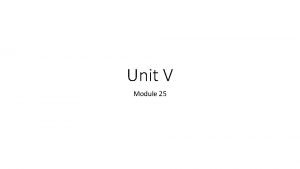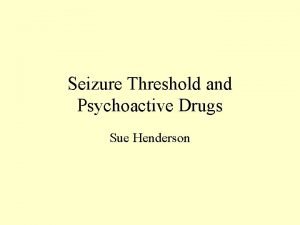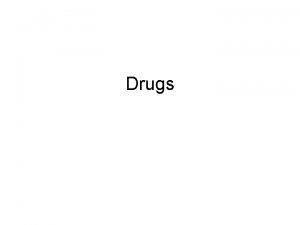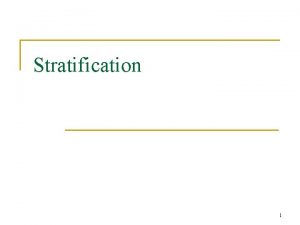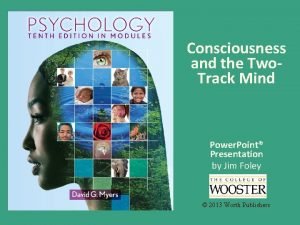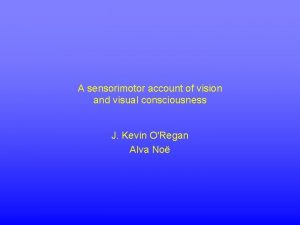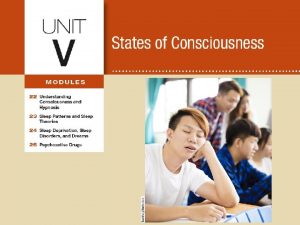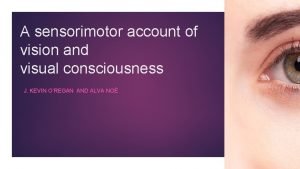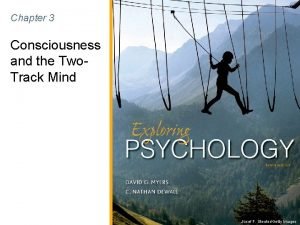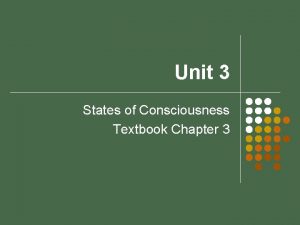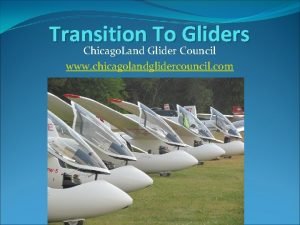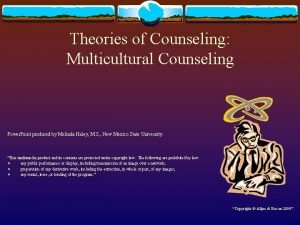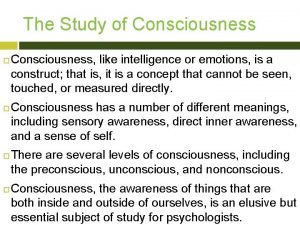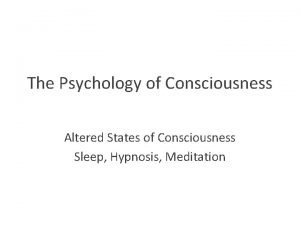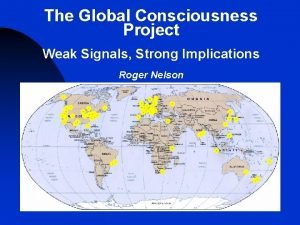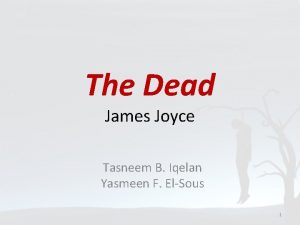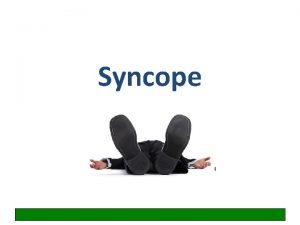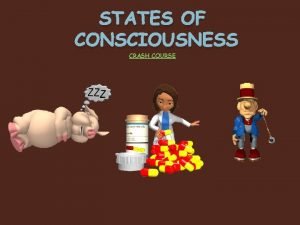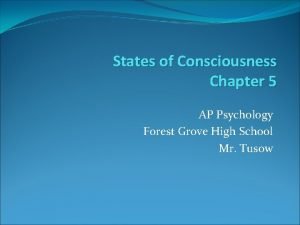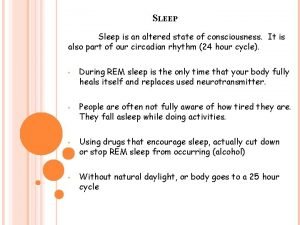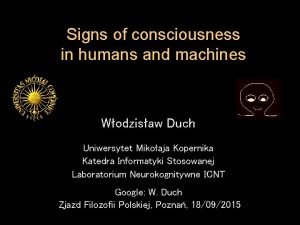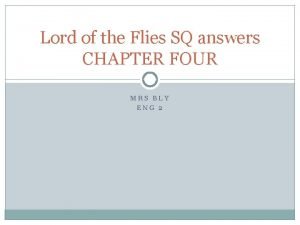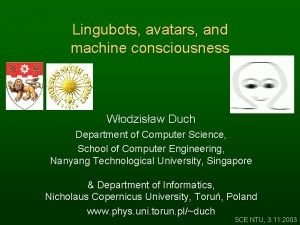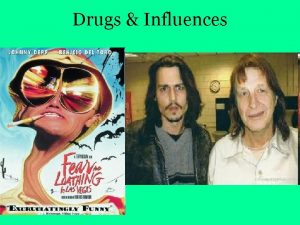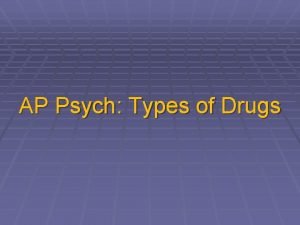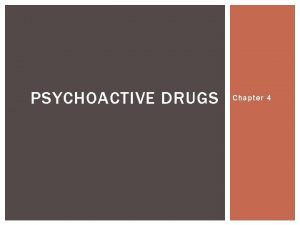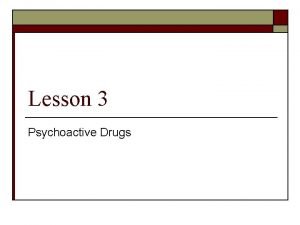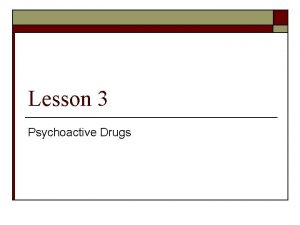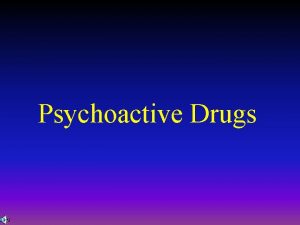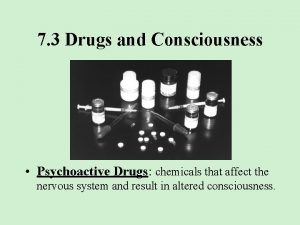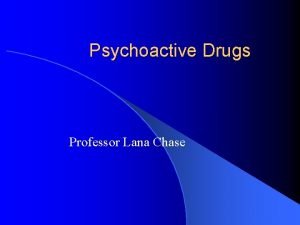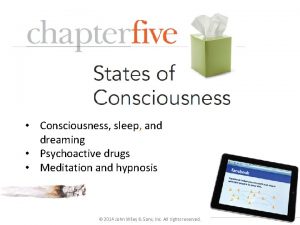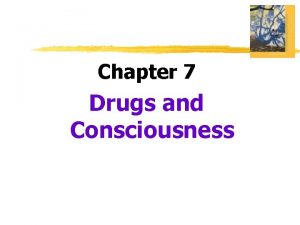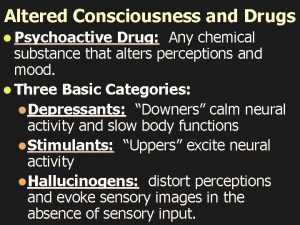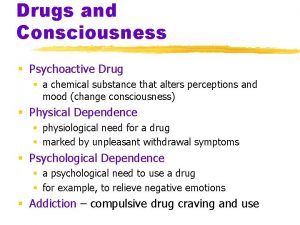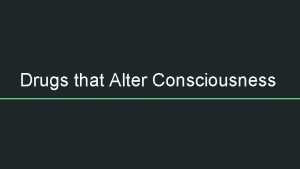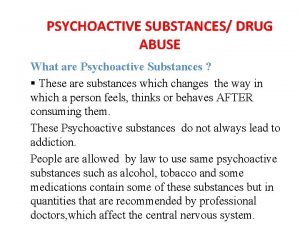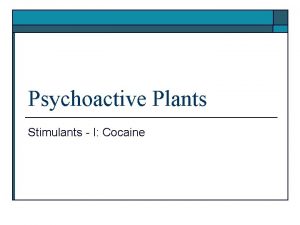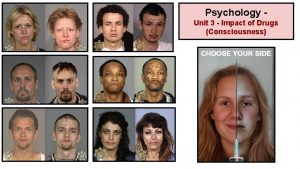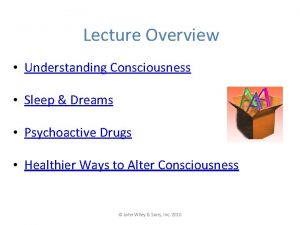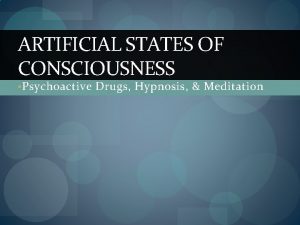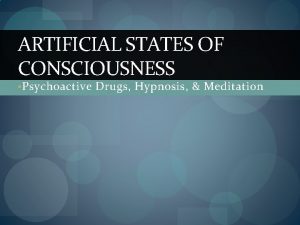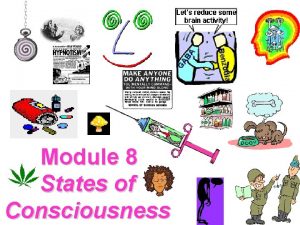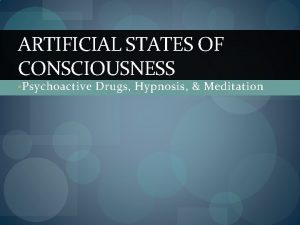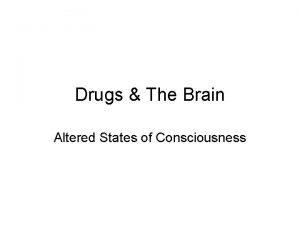Drugs and Consciousness Drugs Consciousness Psychoactive Drugs n


























- Slides: 26

Drugs and Consciousness

Drugs & Consciousness

Psychoactive Drugs n Chemicals that affect the nervous system and result in an altered state of consciousness

How do drugs work? Once ingested are circulated through the body like hormones n Drug molecules effect release of neurotransmitter and/or send their own messages n Alcohol may tell a nerve cell not to fire n LSD might cause circuits to fire in different patterns n

Drug Categories n Psychedelics – Alters cognition and perception n Depressants – lowers arousal levels and reduces excitability n Stimulants – Improves in either mental & physical function or both n Opiates – Derived from the poppy plant

Marijuana Used as an intoxicant n Is illegal in most of the U. S. and Canada n Some evidence that marijuana is more damaging than cigarette smoke n Disrupts memory formation n Difficult to carry out mental & physical tasks n Possibility of dependence n Adult users scored lower than non-users on a grade 12 achievement test n Users have a higher incidence of Psychosis n


Hallucinations Are perceptions that have no external cause: people see, hear, smell, taste or feel things that do not exist n Occur as a result of hypnosis, meditation, drugs, withdrawal from a drug to which one is addicted, psychological maladjustment n

Hallucinogens A. k. a. psychedelics: for their ability to produce hallucinations; create a loss of contact with reality n Best-known, most studied and most potent is LSD (lysergic acid diethylamide) n

LSD n n n Synthetic substance A few millionths of a gram can cause noticeable effects “regular dose” will cause “a trip” 6 -14 hrs in duration Can be terrifying, familiar objects become unrecognizable, sense intermingle, dissociation, panic attacks (never going to get out of it) LSD use peaked in the 60’s; declined because of flashbacks, fear of chromosome damage (unconfirmed)

PCP Phencyclidine n Also known as ‘angel dust’ n PCP is a hallucinogen and anesthetic n Makes you feel invincible n Can cause brain damage n Causes hallucinations, mania, delirium, and disorientation and was deemed unsuitable for medical applications in 1967 n

Psilocybin Mushrooms Known as ‘magic mushrooms’ or psychedelic mushrooms n Contain psychedelic drugs that produce changes in senses n Non-addictive (by chemical standards, you can get emotionally addicted) n A ‘bad trip’ can produce severe panic, mania, hallucinations, and confusion. n

Heroin Derived from the opium poppy, Heroin is the illegal version of a form of morphine (a medical drug for pain) n Severely addictive, which can lead to increased exposure to blood-borne pathogens such as HIV and hepatitis through the use of non-sterile needles n Decreased kidney use n

Crack Cocaine Freebase form of cocaine that can be smoked n Most addictive form of cocaine n Affects brain chemistry, causing euphoria, confidence, loss of appetite, insomnia, alertness, craving for more, and potential paranoia n Severe high, and severe low, increasing depressive symptoms n

Cocaine Stimulant n Elevates mood, increases heart rate n Long term: n – Restlessness, irritability, destruction of nasal walls, weight loss, paranoia, death

Crystal Meth Stimulant n Increases alertness, reduces fatigue, loss of appetite, insomnia, increased heart rate (12 hours) n Long term: n n Restlessness, insomnia, irritability, weight loss, paranoia, depression, suicide, cognitive defects, death

MDMA (Ecstasy) n n Stimulant Single dose may last for 3 to 6 hours Sense of energy and confidence Increases blood pressure, heart rate and body temperature (danger of hyperthermia) • Long term effects: • exhaustion, fatigue, muscle aches, trouble sleeping, anxiety and depression. Flashbacks, delusions, and hallucinations that last after the effects of ecstasy have worn off. • Brain Damage

Opiates Opium, morphine, heroin, special K, oxycodone n Pain reduction, euphoria (pleasurable state: awake – asleep), constipation n Physically addictive n Overdose often results in respiratory failure n

Drug Abuse and Treatment n n Almost all of us have taken a psychoactive drug at some point Where do we draw the line? Drug abusers are people who regularly use illegal drugs or excessively use legal drugs People use drugs for a variety of reasons including; boredom, to fit in, to feel good…to change how people feel

Risks of Drug Abuse n n Death/injury by overdose or accident Damage to health, legal consequences, destructive behaviour, loss of control, effects family and friends Drug abuse does not necessarily mean that one is addicted Addiction is an overwhelming desire or need to obtain and use a drug(s)

Treatment Various forms of treatment…in a generic sense, they all involve the following: n Acknowledge that there is a problem n Must willingly enter a treatment program / get therapy n Support groups/systems to prevent relapse n

Alcohol n n n n “the legal drug” Most widely used and abused drug Most immediate effect is loss of inhibition Actually is a depressant Effects vary depending on tolerance, body weight, Blurry vision, slurred speech, impaired memory & judgment Prolonged use can lead to brain and liver damage, alterations of personality

Alcohol as a Placebo Researchers created a bar n People were given drinks n Males reported being more sexually aroused, became more aggressive and less anxious n Subjects were drinking tonic water n Effects were social in nature n


12 Steps of ‘the program’ 1. 2. 3. 4. 5. 6. We admitted we were powerless over alcohol—that our lives had become unmanageable. Came to believe that a power greater than ourselves could restore us to sanity. Made a decision to turn our will and our lives over to the care of God as we understood Him. Made a searching and fearless moral inventory of ourselves. Admitted to God, to ourselves, and to another human being the exact nature of our wrongs. Were entirely ready to have God remove all these defects of character.

12 Steps of ‘the program’ 7. 8. 9. 10. 11. 12. Humbly asked Him to remove our shortcomings. Made a list of all persons we had harmed, and became willing to make amends to them all. Made direct amends to such people wherever possible, except when to do so would injure them or others. Continued to take personal inventory, and when we were wrong, promptly admitted it. Sought through prayer and meditation to improve our conscious contact with God as we understood Him, praying only for knowledge of His will for us and the power to carry that out. Having had a spiritual awakening as the result of these steps, we tried to carry this message to alcoholics, and to practice these principles in all our affairs.
 Module 25 psychoactive drugs
Module 25 psychoactive drugs Psychoactive drugs definition
Psychoactive drugs definition Psychoactive drugs chart
Psychoactive drugs chart Types of social mobility
Types of social mobility Two-track mind examples
Two-track mind examples A sensorimotor account of vision and visual consciousness
A sensorimotor account of vision and visual consciousness Module 22 understanding consciousness and hypnosis
Module 22 understanding consciousness and hypnosis A sensorimotor account of vision and visual consciousness
A sensorimotor account of vision and visual consciousness Chapter 3 consciousness and the two-track mind
Chapter 3 consciousness and the two-track mind Stream of consciousness technique
Stream of consciousness technique 3 states of consciousness
3 states of consciousness Chicago gliders
Chicago gliders Multicultural counseling ppt
Multicultural counseling ppt Levels of consciousness examples
Levels of consciousness examples Altered state of consciousness psychology
Altered state of consciousness psychology Global conciousness project
Global conciousness project Molly ivors
Molly ivors Loss of consciousness
Loss of consciousness Reciprocal determinism psychology definition
Reciprocal determinism psychology definition Consciousness crash course
Consciousness crash course States of consciousness ap psychology
States of consciousness ap psychology An altered state of consciousness
An altered state of consciousness Signs of consciousness
Signs of consciousness Why did jack want samneric to get him a coconut?
Why did jack want samneric to get him a coconut? The hard problem of consciousness
The hard problem of consciousness Perbedaan awareness dan consciousness
Perbedaan awareness dan consciousness Stream of consciousness technique
Stream of consciousness technique
